Key takeaways:
- Pro-life advocacy requires a balance between supporting unborn lives and addressing the emotional complexities faced by mothers in difficult situations.
- Marginalized voices, such as those of low-income families or individuals facing systemic barriers, must be amplified to enrich the pro-life dialogue and foster empathy.
- Building community support networks empowers individuals facing challenges and creates a collective advocacy environment that validates their experiences.
- Measuring advocacy impact through community perception changes and individual stories highlights the effectiveness of engagement and the ripple effect of uplifted voices.
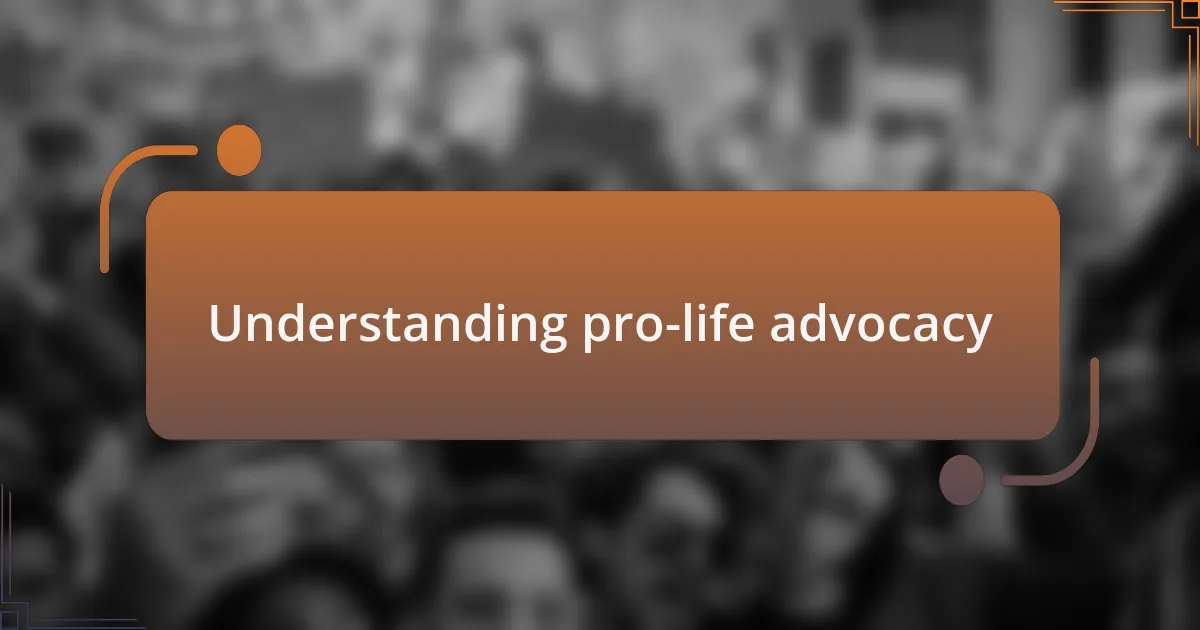
Understanding pro-life advocacy
Pro-life advocacy is often viewed through various lenses, each shaped by personal beliefs and experiences. For me, this perspective was profoundly influenced by witnessing a friend’s struggle with her pregnancy, where her options felt overwhelmed by societal pressures. How do we balance compassion for the unborn while also supporting the complex emotions of those facing unplanned pregnancies?
At its core, pro-life advocacy emphasizes the intrinsic value of every human life, which challenges us to consider not just the unborn child but also the mothers and families involved. I remember a moment when I participated in a roundtable discussion, where a mother shared her fears about raising a child in difficult circumstances. It’s moments like these that remind me of the urgent need to support and uplift the narratives within the pro-life spectrum.
Engaging with the pro-life movement also means listening to voices that are often sidelined. I’ve found that when we open our hearts and ears, we discover stories that reshape our understanding. What if every advocate stepped into the shoes of those they seek to support? Embracing empathy in this journey not only strengthens our resolve but fosters a genuine connection with the marginalized voices we aim to advocate for.
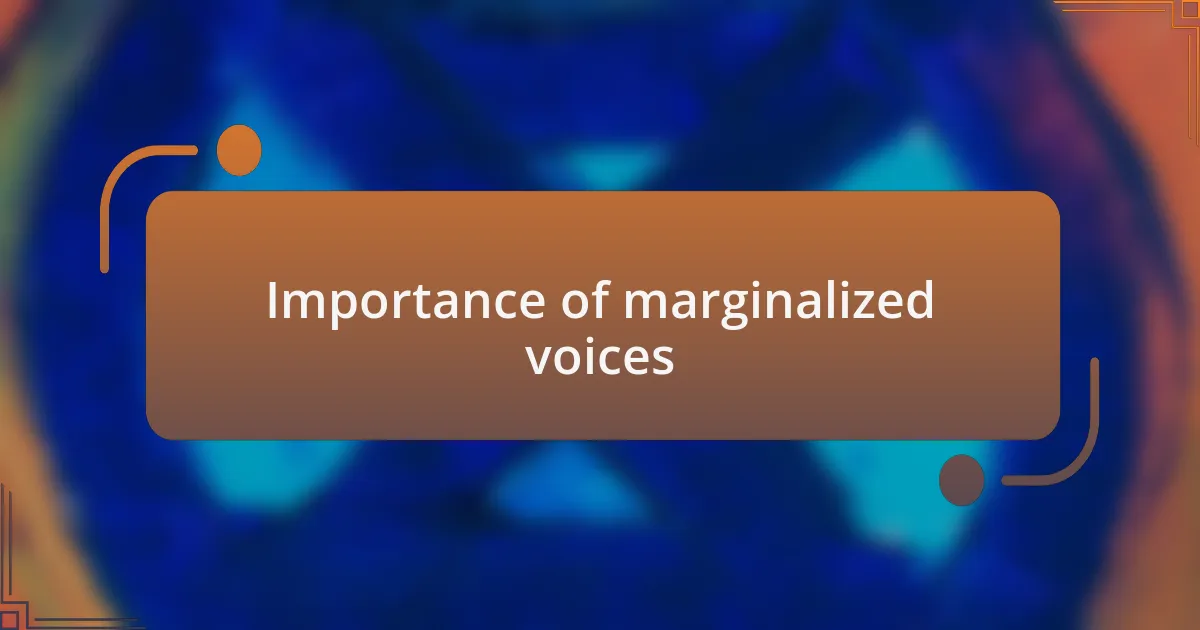
Importance of marginalized voices
Marginalized voices play a crucial role in the pro-life conversation, often providing perspectives that challenge mainstream narratives. I vividly remember a community event where a young woman courageously shared her experience of navigating an unplanned pregnancy while facing systemic barriers. Listening to her story opened my eyes to the intersection of race, poverty, and reproductive choices, reinforcing the idea that we must amplify these voices to create a more inclusive dialogue.
When we center marginalized voices, we enrich our understanding of the complexities involved in pregnancy decisions. I once attended a workshop led by activists who focused on the unique challenges faced by low-income families seeking healthcare. Their insights not only deepened my awareness of economic disparities but also highlighted the urgency to advocate for policies that support these communities. Isn’t it vital that we address the root causes of their struggles?
Fostering a dialogue that includes marginalized perspectives encourages empathy and compassion in the pro-life movement. During group discussions, I often find that when we hear firsthand accounts of fear, hope, and resilience, we move beyond theoretical debates and connect on a human level. How can we truly advocate for life if we overlook the lives that society tends to ignore? Each voice brings invaluable context, reminding us that the pro-life message must be inclusive and compassionate, ensuring that no story goes unheard.

Challenges faced by marginalized groups
The challenges faced by marginalized groups are often exacerbated by a lack of access to essential resources. I remember speaking with a single mother who struggled to find affordable childcare while juggling her job and caring for her child. This lack of support not only affects her ability to work but also places immense emotional strain on her and her family. How can we expect individuals to thrive when they encounter such overwhelming barriers?
Another significant challenge is the misrepresentation of their stories within the mainstream pro-life dialogue. I once listened to a powerful testimony from a woman whose identity as a black mother was overshadowed by stereotypes and biases. Hearing her articulate the intersection of race and motherhood struck a chord within me, prompting me to question whether our discussions truly capture the complexity of their experiences. Isn’t it crucial that we shift the narrative to better reflect these realities?
Moreover, systemic issues like discrimination can further alienate marginalized individuals from receiving support and understanding. I remember a community meeting where an immigrant woman shared the fear she felt every time she sought medical assistance due to her legal status. This fear is all too common and highlights the urgent need for advocacy that reaches beyond mere policy changes to address the emotional and psychological toll of these challenges. How can we build a compassionate movement if we don’t actively dismantle the barriers that keep these voices silent?
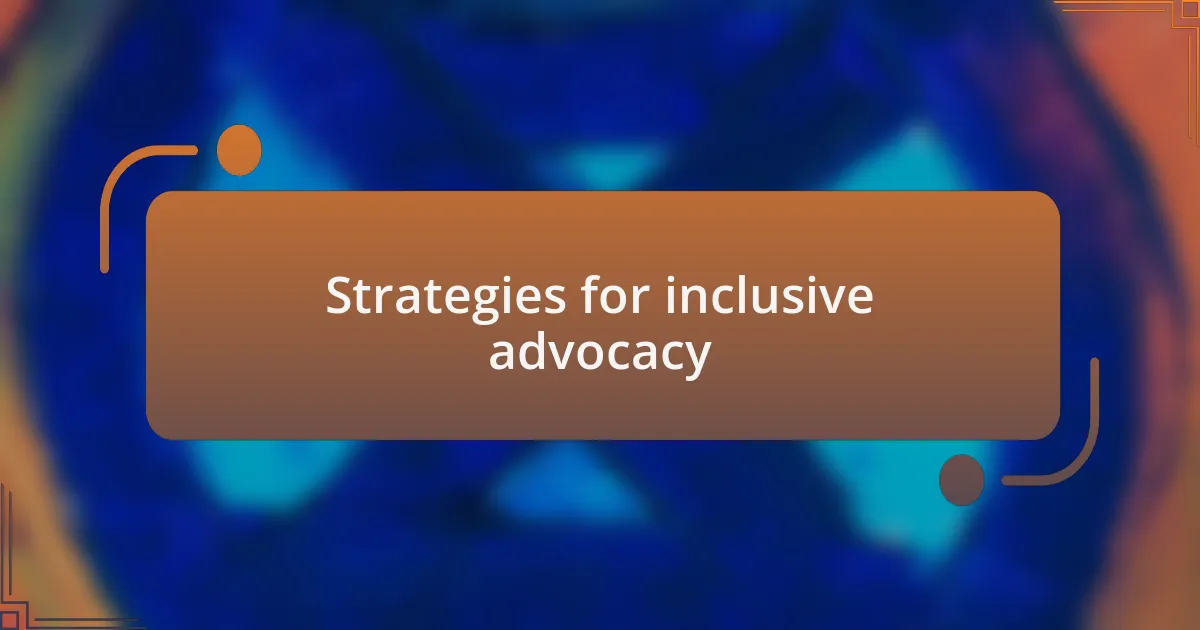
Strategies for inclusive advocacy
Inclusive advocacy starts with listening actively to the voices of those we aim to support. I once joined a focus group where individuals from marginalized communities shared their personal experiences. The diversity of their stories opened my eyes to the nuances of their challenges, reminding me that advocacy is not about speaking for them, but rather amplifying their voices and ensuring they are heard.
Creating safe spaces for dialogue among diverse groups is another effective strategy. During a community event focused on reproductive health, I witnessed a transformative moment when individuals from different backgrounds came together to share their struggles and hopes, breaking down silos of ignorance. This camaraderie illustrated the power of community in advocacy; by fostering open communication, we can build trust and understanding across varying perspectives.
Collaboration with grassroots organizations can also enhance our advocacy efforts. In my experience, partnering with local groups that already serve marginalized communities can broaden our reach and deepen our impact. Through these collaborations, I learned to appreciate their established networks and insights, showing me that when we unite our efforts, we foster a more inclusive movement that truly represents the needs and voices of all individuals.
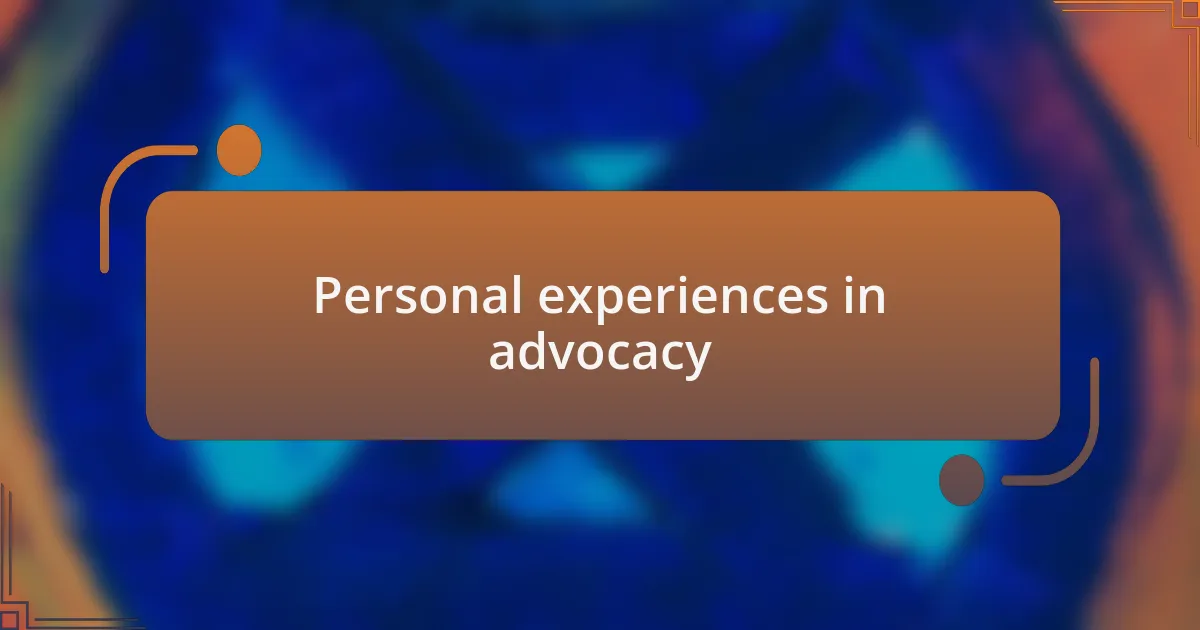
Personal experiences in advocacy
There was a time when I volunteered at a local clinic that served underserved populations. I remember sitting down with a young woman who was navigating a difficult decision regarding her pregnancy. As she spoke, I could feel the weight of her words, and I realized that sometimes, just being there to listen was the most profound form of advocacy. How often do we rush to give solutions when what people truly need is to be heard?
In another instance, during a panel discussion focused on reproductive rights, a participant shared her story of facing systemic barriers that restricted her access to care. I couldn’t help but feel a mix of anger and compassion. It struck me that her experience was not unique; many individuals face invisible walls that often go unchallenged. It was a reminder that our role as advocates is to dismantle those barriers, ensuring that everyone has the opportunity to make their own choices without fear.
One powerful moment came when I attended a rally advocating for maternal health equity. I stood alongside mothers from diverse backgrounds, each sharing their unique narratives of resilience and struggle. Their emotions resonated with me deeply, and I thought, how can we bring these stories to a wider audience? Each voice was a thread in a larger tapestry of advocacy, and it became evident that our collective experiences have the potential to drive change when told authentically.
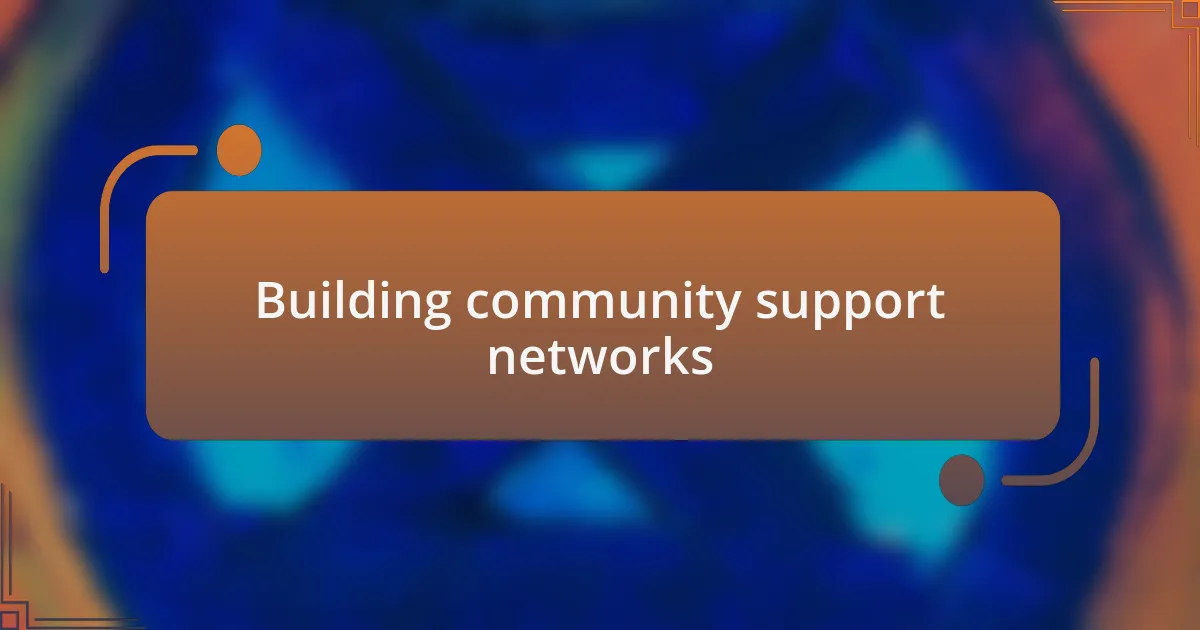
Building community support networks
Building community support networks is essential for amplifying marginalized voices. I recall a time when I was part of a grassroots organization that connected individuals facing similar struggles. We formed small groups where we not only discussed our experiences but also shared resources. It was incredible to see how a sense of belonging can foster confidence and empower people to advocate for themselves.
I often think about the friendships forged in those meetings. One woman, who initially felt alone in her journey, found solace in the stories shared by others. We cheered her on as she made her first public statement about the challenges she faced. Witnessing her transformation was a reminder that when we unite, we create an environment where everyone feels supported and validated. How powerful is that?
Moreover, establishing these support networks can directly impact the larger community. I remember organizing a local event where diverse voices came together to speak about their experiences. The energy was palpable, and the attendees left inspired to take action. It made me wonder, how can we sustain this momentum? By continuing to provide platforms for these voices, we not only foster understanding but also cultivate a culture of advocacy that extends beyond the individual.
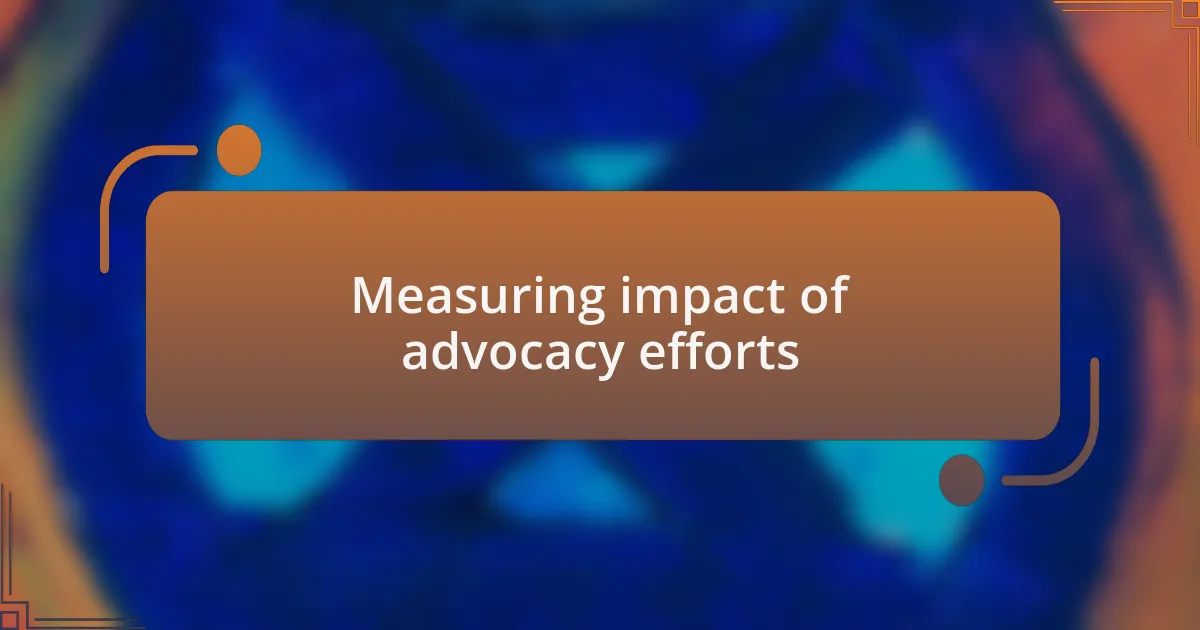
Measuring impact of advocacy efforts
Measuring the impact of advocacy efforts can often feel like navigating uncharted waters. From my experience, tracking changes in community attitudes and awareness provides valuable insight into how our initiatives resonate. I once participated in a campaign that conducted pre- and post-surveys to gauge shifts in public perception. The results were eye-opening, revealing how informed conversations led to increased understanding and empathy. Can you imagine the power of seeing those numbers reflect real change?
Another approach I’ve found effective is documenting individual stories of transformation. Recently, I spoke with a participant in our advocacy training who shared how the program not only improved her confidence but also inspired her to become a mentor for others. Her journey, reflected in qualitative data, illustrated the ripple effect of our efforts—every voice uplifted can empower another. How do we capture such profound change beyond mere statistics?
Finally, social media analytics can serve as a modern barometer for engagement. A campaign I was involved in tracked the number of shares and interactions on posts featuring marginalized voices. I remember the thrill of seeing our message spread far and wide, reaching audiences we never anticipated. It’s a reminder that while numbers can be daunting, they also reflect our growing community and the effectiveness of our advocacy. How can we continue to harness these tools for greater impact moving forward?